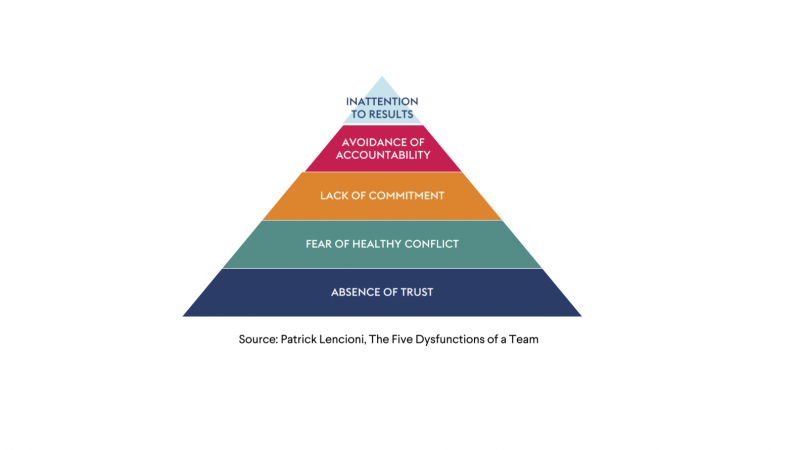As we embark on 2023, corporate Australia continues to face major challenges: high inflation, price rises, supply chain disruption, a tight labour market and a national skills shortage. As executive teams adapt to the changing market conditions, they must sometimes make risky decisions and radical shifts in strategy. Yet at Serendis, we’ve observed that executive teams are avoiding the conflict of ideas and opinions that we’d expect in this uncertain and volatile environment. Without this robust debate, teams risk making poor decisions, or not generating the commitment they need to support their bold and strategic changes.
So, why aren’t leadership teams embracing debate and healthy conflict? The answer is that they lack the levels of trust they need to do so.
The connection between trust and healthy conflict
Trust is a vital feature of high performing leadership teams. But that trust has been eroded over the COVID years, for a number of reasons, including that:
- teams haven’t spent much time together in-person
- the composition of many teams changed during COVID, and
- with teams so focused on their organisation’s immediate needs, they’ve invested more time in the execution of operational matters than in developing and maintaining trust with their peers.
At Serendis, we use the model developed by Patrick Lencioni, an American expert on business management and executive teams.
The base of Lencioni’s ‘Five Dysfunctions of a Team’ pyramid (below) is the absence of trust, as trust is the foundation of teamwork. Lencioni’s pyramid also illustrates how, if a leadership team hasn’t established enough trust between its members, it can’t overcome the next dysfunction in the pyramid, which is fear of conflict.
 That is, if teams don’t have a high level of trust, it’s unlikely that team members will lean into the discomfort of challenging each other, or take a risk by suggesting a different approach to the rest of the team. And that can be detrimental, because:
That is, if teams don’t have a high level of trust, it’s unlikely that team members will lean into the discomfort of challenging each other, or take a risk by suggesting a different approach to the rest of the team. And that can be detrimental, because:
- It can cause the team to default to groupthink, which is more comfortable but often excludes perspectives which could be critical to the decision, or
- Even if the team makes the best possible decision, it can create a situation where parts of the executive team don’t genuinely agree with the decision, which can lead to dissension in the organisation.
Let’s look at this second scenario in more detail.
For organisations to confront today’s challenges, they need all members of their leadership team to have a strong commitment and alignment to the decisions they make. But, if executive team members aren’t united on a particular decision (even if some members disagree at first), then the team hasn’t actually committed to that decision.
For example, say a CEO, or part of an executive team, decides they’re going to take their organisation in a certain direction, and they develop a corresponding strategy. However, one or more team members feel they don’t have a voice to challenge that decision, or that their opinion hasn’t been valued – that is, they don’t feel part of the decision-making process. That team member(s) is then less likely to truly support the new direction and strategy. And as soon as challenges arise in relation to the strategy, the team member(s) who felt marginalised will undermine it.
Worse, if people within the organisation challenge the new strategy, the team members who didn’t genuinely agree are likely to sympathise with the challengers. And that creates pockets in the business that are sabotaging the strategy.
So, without healthy conflict – without leaders being able to engage in passionate dialogue around key issues and decisions, without them being comfortable to question and disagree with one another, without them feeling safe to bring their perspectives to each other – they’re not generating the buy-in from the team that’s needed to achieve optimal outcomes, and for decisions to be successfully implemented.
At Serendis, we’re seeing a pattern of lack of trust within leadership teams. It isn’t always apparent – often there’s no obvious dysfunction in the team. But the team’s level of trust isn’t strong enough, and it’s impacting their ability to successfully respond to issues posed by the current economic climate. Some examples of the tough decisions we’ve seen organisations having to make include: backing one product instead of another; creating a new venture which exposes the organisation to risk; or having to reduce their workforce after not growing fast enough to support their costs.
To succeed in such a challenging environment, it’s imperative that leadership teams experience high levels of safety, where each team member is comfortable taking risks, and discussing their weaknesses, fears and mistakes. Here’s how trust can be built and boosted within leadership teams.
Unlocking vulnerability to boost trust
Trust requires people to be vulnerable with each other; to be very open about who they are, when they’ve made a mistake, and what they’re good and not so good at. On the flipside, this means trust can also be gained and deepened through exposing vulnerability.
At Serendis, we take executive teams offsite and facilitate a safe space where leaders can come together and be vulnerable with one another, in order to enhance trust within the team. We take each leader on a journey of deep personal reflection and awareness, asking them to identify and share life experiences which have shaped their values and strengths, and which have also shaped aspects of their personality that derail them. (Examples of such ‘derailers’ include the need to be liked, the need to be right, and the need to please others.) We ask each leader to create a statement about their leadership purpose, and facilitate feedback from other team members.
We find that this sharing of stories and feedback between team members creates empathy among their peers. For example, if a leader has perfectionist tendencies, and that person can articulate, with humility, what drives them and the reasons for their perfectionist streak (and often, it’s linked to childhood experiences or parental influences), it generates a level of empathy in the rest of the team. This allows other team members to recognise their colleague’s behaviour and gently challenge it when, for example, that leader’s need for perfection stops them from making decisions when they don’t have all the facts.
It certainly isn’t easy to get high-achieving individuals to share their vulnerable sides, especially in a culture where vulnerability has historically been seen as weakness. But the truth is, being vulnerable requires strength, courage and resilience. As we move out of COVID and leadership teams confront ever-evolving challenges and disruption, the connection between vulnerability, trust, confronting groupthink, and optimal decision-making is more important than ever.



